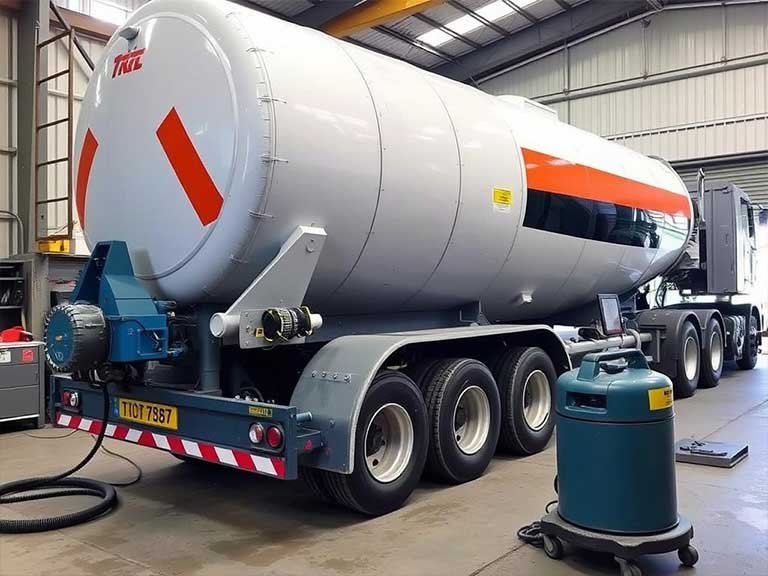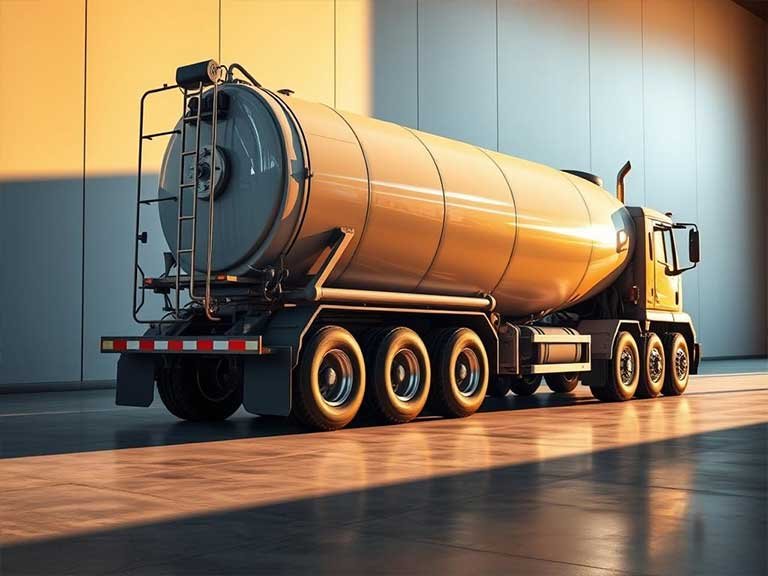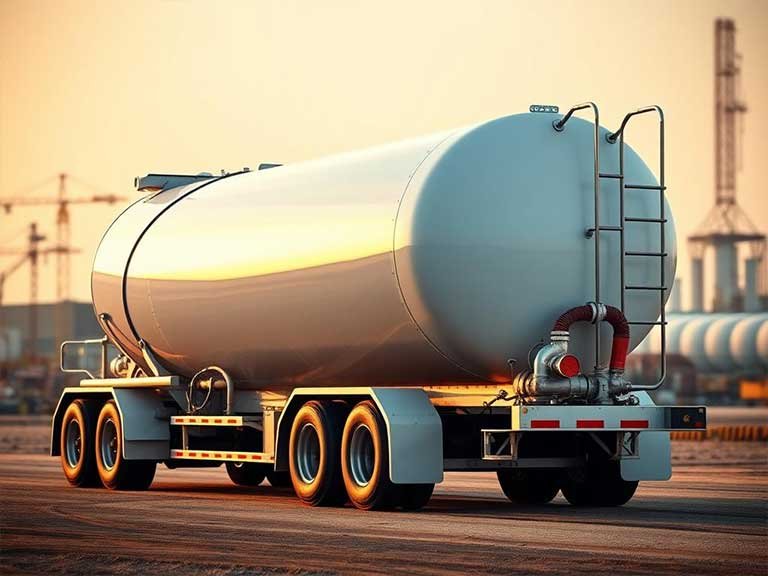Are you wondering how to optimize your cement transportation operations for large-scale construction projects? At Genron International Trade, we specialize in designing and manufacturing semi-trailers, including bulk cement tankers with capacities ranging from 25 to 120 tons. Our cement tankers are engineered to meet the diverse needs of our clients across Africa, Southeast Asia, and beyond.
With our expertise, we provide customized trailer solutions that enhance transportation efficiency while maintaining safety standards. Our bulk cement transportation solutions are designed to maximize load capacity and durability.
Table of Contents
Understanding Bulk Cement Tanker Trailers
At Genron International Trade, we manufacture cement tanker trailers that are designed to meet the demands of large-scale construction projects. Our bulk cement tanker trailers are specialized semi-trailers engineered for the efficient transportation of powdered materials like cement, fly ash, and lime powder.
What Are Bulk Cement Tankers?
Bulk cement tankers are designed to transport large quantities of cement and other powdered materials without packaging. These tankers utilize pneumatic systems, powered by an air compressor, to fluidize cement particles, enabling efficient loading, transport, and unloading operations.
Working Principles of Cement Tanker Trailers
The working principle of cement tanker trailers involves creating pressure differentials within the sealed tank to move cement through pipelines. This allows for vertical transportation heights of over 30 meters. Key components include air chambers, fluidized beds, and discharge systems that work together to ensure efficient material flow. Understanding these principles is crucial for optimizing transportation logistics and ensuring the proper utilization of these specialized vehicles.
- Bulk cement tankers are designed for transporting powdered materials in large quantities.
- They utilize pneumatic systems for efficient operations.
- The working principle enables vertical transportation heights of over 30 meters.
- Specialized components ensure efficient material flow.
Begin with a bespoke semi-trailer designed for your exact needs. Whether it’s heavy-duty hauling or specialized cargo, we’ve got the perfect solution to keep you moving forward.
Bulk Cement Tanker Capacity Options
We offer a range of bulk cement tanker capacities designed to meet different project requirements. Our bulk cement tanker capacity options are designed to accommodate various transportation needs, ensuring efficient logistics and reduced costs.
Standard Capacity Ranges
Our bulk cement tanker capacity options range from 25 tons to 120 tons, with corresponding volumes from 20 cubic meters to 100 cubic meters. Standard capacity models include 30-ton (25 feet), 40-ton (28 feet), 50-ton (33 feet), 60-ton (36 feet), 85-ton (41 feet), and 120-ton (46 feet) configurations.
Specific dimensions for these models are as follows: a 30-ton cement tanker is typically 7500mm in length, while a 40-ton cement tanker is 8500mm. Larger models, such as the 50-ton and 60-ton tankers, measure 10000mm and 11000mm in length, respectively.
Factors Affecting Capacity Selection
When selecting the appropriate capacity, factors such as transportation distance, construction project size, road conditions, and loading/unloading facilities must be carefully considered. The loading capacity of a cement tanker is directly influenced by its design specifications, including tank shape, material thickness, and structural reinforcement features.
Larger capacity tankers offer economic advantages for high-volume projects but require consideration of weight restrictions, maneuverability limitations, and infrastructure compatibility. We provide customized capacity solutions based on specific client requirements, ensuring an optimal balance between loading capacity and operational efficiency.
Dimensions and Specifications of Cement Tankers
Understanding the dimensions and specifications of cement tankers is vital for logistics planning. We design our cement tankers with precise dimensional calculations to optimize the volume-to-weight ratio, ensuring maximum payload capacity within legal transportation limits.
Height and Length Specifications
The height of our bulk cement tanker trailers is key for safe transport. They are usually between 3.5 meters and 3.95 meters (11-13 feet) tall.
- Standard cement tanker height ranges from 3.5 meters to 3.95 meters, with careful consideration given to overhead clearance requirements.
- Tank length specifications vary according to capacity, ranging from 7,500mm for 30-ton models to 14,500mm for 120-ton models.
- Height considerations are particularly critical for safety and accessibility.

Width and Weight Considerations
The size of cement tankers must balance capacity with road rules and practical needs.
- All our designs maintain a standard width of 2,500mm (8 feet).
- Weight distribution across the tanker’s axles is carefully engineered to comply with axle load regulations.
- Each tanker model is designed with specific cbm capacities that correspond to their tonnage ratings.
Materials and Construction
Our cement tanker trailers are made with top materials for strength and reliability. The choice of materials is key to their durability and performance.
Carbon Steel vs. Aluminum Tankers
We mainly use high-strength carbon steel plates (5-6mm thickness) for our tank bodies. They offer great durability and strength. Carbon steel is cost-effective and strong, making it the top choice for cement transport. Aluminum tankers, on the other hand, are lighter, increasing payload and fuel efficiency.
Tank Body Construction Features
The tank body is built with advanced welding and reinforcement for up to 0.2MPa pressure. Our process includes quality checks and pressure tests for strength.
Key Components of Bulk Cement Tankers
Knowing the key parts of bulk cement tankers is vital for their safe use. These parts work together for efficient cement transport.
Air Compressor Systems
The air compressor system is key for unloading. We use high-quality air compressors, often with WEICHAI or Deutz diesel motors. They can create 0.2MPa pressure.
- Advanced pressure systems keep the tank at the right pressure.
- The compressor is built for efficient use and easy upkeep.
Discharge Systems and Valves
The discharge system is crucial, with well-made pipelines, valves, and connectors. Our tankers can discharge up to 30 meters vertically.
- The tank uses fluidized bed technology to reduce residue.
- Safety systems and pressure relief valves prevent over-pressurization.
- The discharge parts are easy to maintain and service.

Loading and Unloading Processes
Our tankers are designed for safe and efficient loading and unloading. The process includes important steps for safe material transfer.
Loading Procedures and Safety Measures
Loading starts with equalizing pressure. Operators must open relief valves and then the manhole covers for loading. Safety steps include correct positioning, securing brakes, and checking all indicators before loading.
Before opening the feeding cover, it’s key to open the pressure relief valve and the inlet pipe ball valve. This removes air and prevents injury.
Efficient Unloading Techniques
The unloading process uses compressed air to turn powder into a semi-liquid state. This makes it flow well through discharge pipes. Our tankers can unload up to 1.5 tons per minute thanks to smart air pressure and design.
Handling powder well needs the right valve timing and air pressure. Our tanks are designed to load fast and leave little residue. Unloading usually takes 30-40 minutes.
Maintenance and Care Requirements
Keeping cement tanker trailers in good shape is key. Regular checks help prevent wear and tear.
Regular Maintenance Procedures
Check the tank for leaks and the air compressor system. Make sure the truck engine is running well. Look for air leaks around manholes and valves often.
- Inspect tank body for weld integrity and leaks
- Check air compressor system lubrication and filter replacements
- Maintain truck engine and power take-off systems
Extending Tanker Lifespan
To make your tanker last longer, follow a detailed maintenance plan. Prevent corrosion, clean the tank, and coat vulnerable spots.
- Implement corrosion prevention measures
- Regularly clean material residue from the tank body
- Apply protective coatings to vulnerable areas

Conclusion: Choosing the Right Bulk Cement Tanker
Genron International Trade knows how hard it is to pick the right bulk cement tanker. Think about how much you need to carry, how far you’ll travel, and your local conditions.
We make custom cement tankers for Africa and Southeast Asia. Our cement trailers can carry from 25 to 120 tons. They’re made to fit your needs and follow local rules.
Think about your roads, travel distances, and maintenance options when picking a cement tanker. We offer support and customization for our trailers. The right cement tanker can save you money and last longer. Contact us for advice on the best tanker for you.
FAQ
What is the typical loading capacity of a cement tanker trailer?
Our tankers can carry from 25 to 120 tons. It depends on the model and your needs.
What are the key factors to consider when selecting a cement tanker trailer?
Look at the capacity you need, the material you’re moving, and the roads you’ll use. These all matter when choosing a tanker.
How often should I perform maintenance on my cement tanker trailer?
Regular checks are key to keeping your tanker in good shape. We suggest checking every 3-6 months, or as the maker says.
Can I customize the dimensions and specifications of the cement tanker trailer?
Yes, we can tailor a tanker to fit your needs. We’ll design one that suits your height, length, and width requirements.
What is the average lifespan of a well-maintained cement tanker trailer?
A cement tanker trailer can last 10-15 years or more. This depends on how well it’s maintained and the conditions it’s used in.


